The Ultimate Guide To Customer Experience
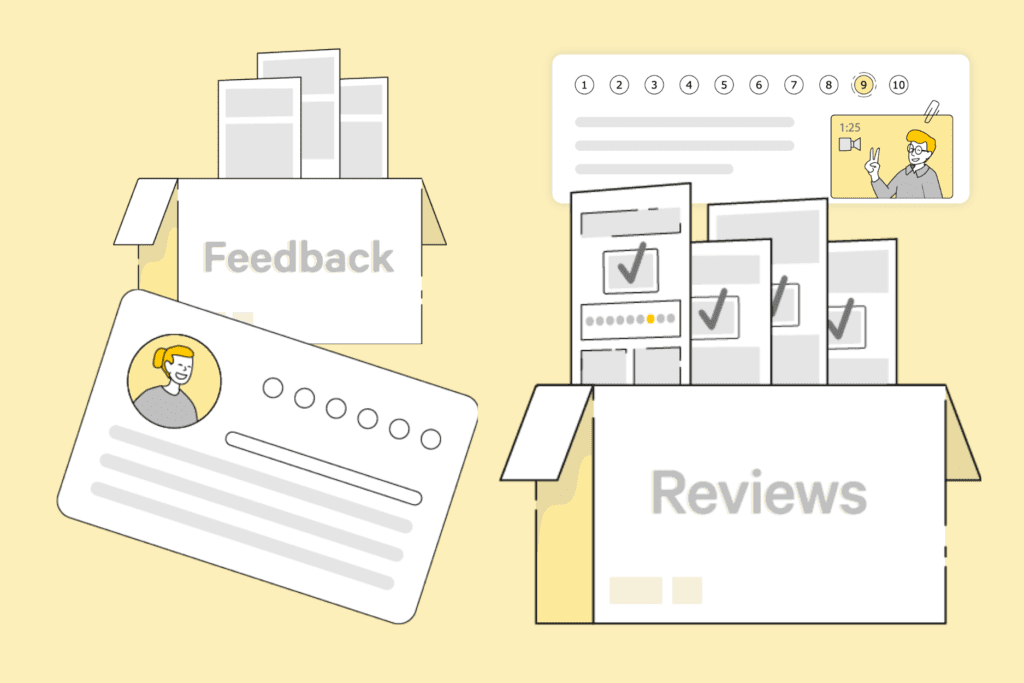
Steve Jobs said, "You have to start with the customer experience and work backward to the technology."
Jeff Bezos says, "It's our job every day to make every important aspect of the customer experience a little bit better."
Warren Buffet notes, "Any business with delighted customers has a sales force they won't have to pay."
Why do these market leaders focus so much on customer experience?
The simple answer is that they understand its importance. They know that providing the customers with an everlasting experience is a sure-shot way to ensure business growth by gaining competitive advantage over competitors.
Furthermore, good customer experience examples are everywhere, you just have to keep an eye out for them.
Try our free customer experience survey to get the first glimpse into how your customers currently see you!
What Is This Guide About?
This guide will help you understand all there is to know about customer experience. You will learn:
- How to measure customer experience quantitatively and qualitatively.
- The best metric for measuring customer experience.
- How to use different channels to connect with customers to gather feedback.
- When and how to measure customer experience during the customers' journey.
- How to analyze and improve customer experience.
- Various software for measuring customer experience.
- The relationship between employee and customer experience.
What Is Customer Experience? Why Is It Important?
Customer experience is defined as the complete experience of your customer when dealing with the company.
It helps you step in the customer's shoes and experience their reality as they interact with your brand. Thus, it incorporates various factors, such as:
- emotions
- attitudes
- responses
- behaviors
- repurchase intentions
Furthermore, it helps you understand the needs of the customers and tailor your business strategy accordingly.
An exceptional customer experience can help your brand stand out from the competition. Moreover, it can become the cornerstone of unparalleled success by converting potential clients.
"Excellent customer service is the number one job in any company. It is the personality of the company and the reason customers come back. Without customers, there is no company." – Connie Elder
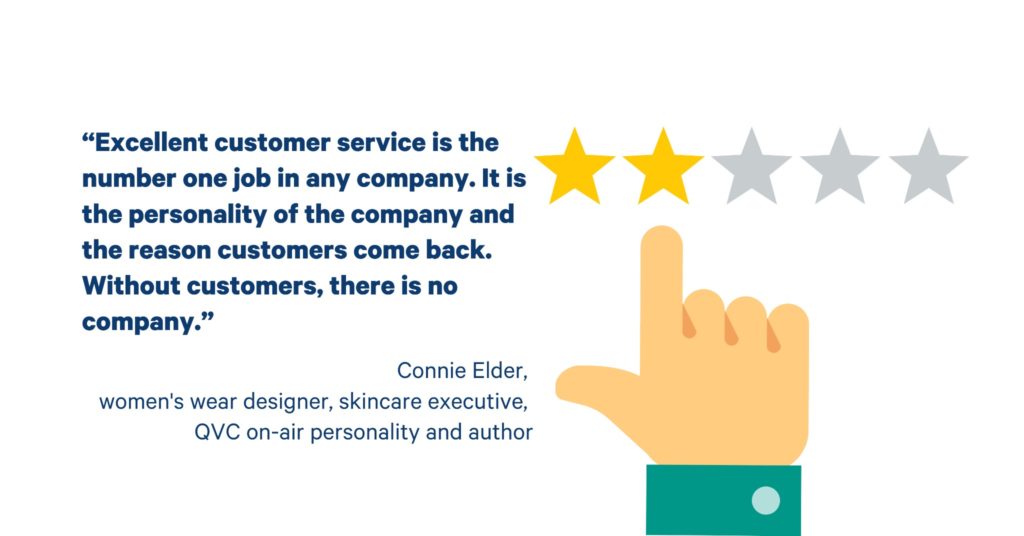
How To Measure Customer Experience?
Connecting customer experience with business results is the key to any successful company. But, to do that, we must learn various ways to actually measure the customer's experience.
These metrics are divided into two categories: quantitative and qualitative. We'll go through these categories in the following section.
8 Quantitative Metrics
Quantitative metrics are defined by a set number that represents the results. These numbers offer general facts.
Furthermore, they help showcase the change from one strategy to the other.
The following are eight of the most common quantitative metrics.
1. NPS
Net promoter score (NPS) provides insight into customers' perceptions of your business. This percentage can range from -100% (not recommended at all) to +100% (recommended to friends and family).
It is measured using a practical and straightforward question, "How likely are you to recommend this business to a friend or colleague?"
The scale ranges from '0' being least likely to '10' most likely.
- People who answer between 0 – 6 are known as detractors.
- The ones who answer 7 – 8 are passive and not included in the calculation.
- Lastly, people who answer 9 – 10 are called promoters.
NPS is the difference between the total number of detractors from the total number of promoters
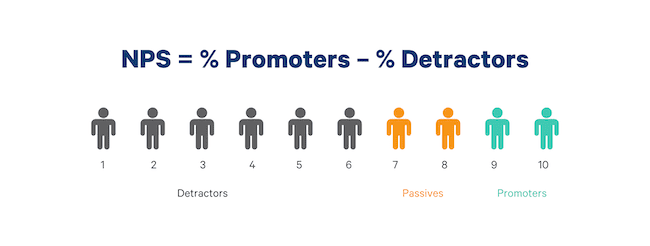
NPS surveys are a great way to find out who your loyal customers are and collect their testimonials.
Read our NPS, and how do you measure it? for more details.
2. CSAT
Next, we will look at CSAT or customer satisfaction. This score represents customers' satisfaction regarding a specific experience.
CSAT surveys work wonders as in-the-moment measure. Thus, it can be broken into individual questions that focus on specific areas of services.
Compared to NPS, CSAT offers an insight into what the customers think about your services right now.
The following is an example of a CSAT survey.
3. CES
The Customer Effort Score measures the effort customers exert to get desired outcomes. It includes ordering a product or speaking to a customer service representative.
The usual question in CES is, "how easy was it to solve your problem today?"
NPS and CSAT give us an average score. However, CES provides a distribution. It helps identify customers who had no trouble going through your services effortlessly.
Furthermore, it can also help identify people who struggled. Thus, you can pinpoint customers who might need a more personal touch to solve their problems.
Here is an example of gathering CES scores.
CES helps you identify complicated processes in your services. A complex process can introduce friction, which customers don't appreciate. Streamlining the process can help negate that.
94% of customers going through an effortless experience are likely to repurchase. In contrast, only 4% of those who went through a high level of effort will come back to the same brand.
Heres a quick over-view of the pros and cons of the three metrics.
- NPS focuses on customer loyalty
- CSAT is used to understand the level of customer satisfaction
- CES is a transactional metrics that indicates how much of a struggle a customer has to go through to get their issue solved.
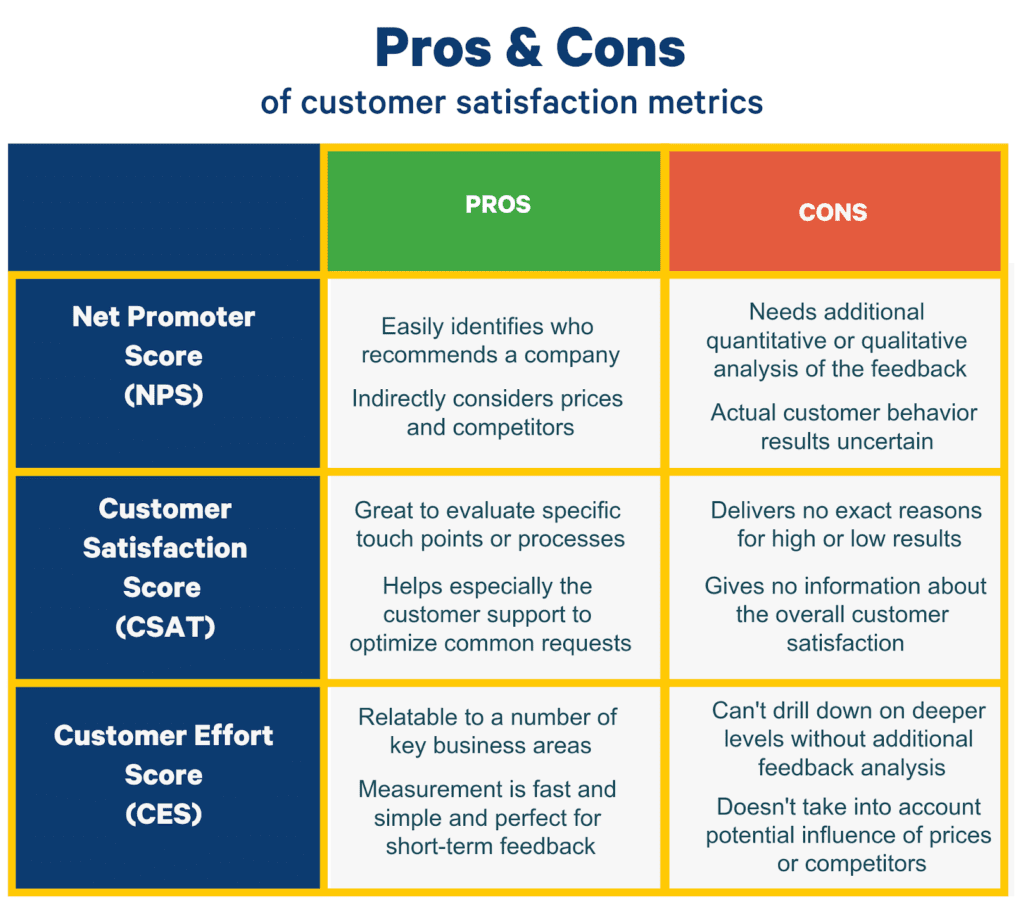
4. Customer Retention Rate
The customer retention rate is linked with customer loyalty. It helps analyze the number of customers that stayed with the brand over a period of time.
According to a Temkin Group study, loyal customers are five times more likely to repurchase a product or service. They are also more likely to forgive shortcomings. Furthermore, they are four times likely to refer and seven times more eager to try a new product or service.
Customer retention rate is also linked with customer churn rate, which we will look at in the following section.
5. Customer Churn Rate
Customer churn rate is the percentage of customers who cancel their subscriptions.
Calculating the churn rate is straightforward. Just divide the number of customers lost by the total number of active customers for a given time frame.
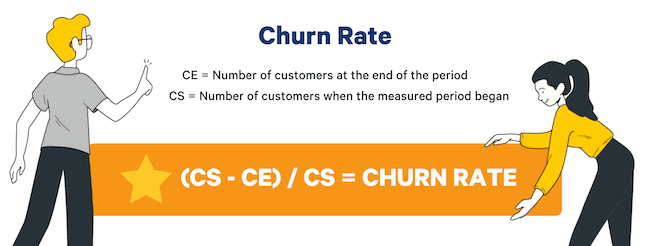
When measuring the churn rate for subscription-based companies, defining what it means to lose a customer (churned) is crucial. For example, if a customer has not continued their subscription within 90 days, they may be considered 'churned.'
6. First Contact Resolution
The first contact resolution rate shows resolved tickets within a single response. The higher this number, the better.
A high first contact resolution rate gives you an edge over the competition. It means that your team and process are running efficiently.
Yet, that is easier said than done. Customers might want extra information or have follow-up questions.
Working with your team to plan proven replies that can help increase the first contact resolution rate.
An example of such responses could be, "Is there anything else I could help you with?"

7. Average Resolution Time
A reply is not a resolution. Simply making contact isn't enough to resolve the issue at hand.
The average resolution time is the time it takes to resolve the customers' issues. This time should be as low as possible to allow your team to handle many clients.
One way to decrease the average resolution time can be to share knowledge with your customers. Thus, allowing them to do their research and come up with solutions.
Another way can be to train your team with effective responses which help resolve the issue in the least amount of time possible.
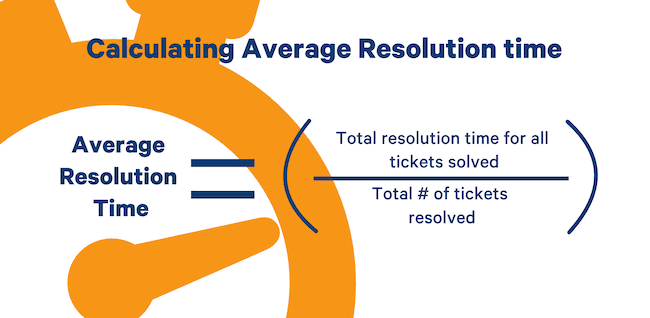
8. Customer Referral Rate
The customer referral rate compares total sales with sales due to referrals.
For example, if your referral rate is 5%, that means 5 in every 100 purchases come from referral programs.
This metric relates to the customer experience and can be linked with NPS.
NPS promotors will refer your product and services to their friends and colleagues. Hence, increasing 'promoters' can increase referral purchases and positively impact your profits.
In summary, quantitative metrics help you see the numbers behind the customers' relationship with your brand. Furthermore, they can also help you predict various changes in revenue.
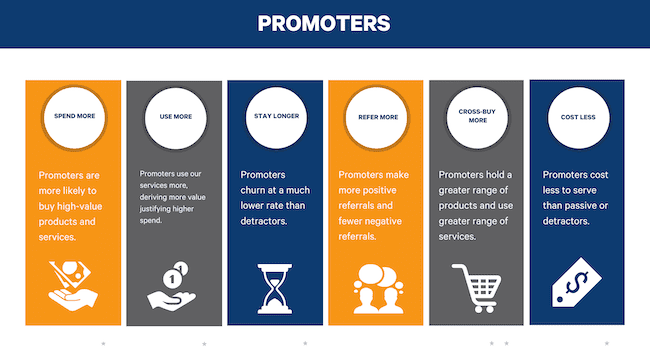
5 Qualitative Metrics to Try
Numbers are well and good, but if you want a complete picture of the customer experience, you need qualitative research or feedback.
Qualitative metrics help customers express their thoughts and emotions in words. They help understand parts of the experience the customer appreciated and parts that weren't too pleasing.
The following are five ways you can collective qualitative customer experience data.
1. Observation
Observing the customers allow you to notice their behaviors. Furthermore, you can identify factors and patterns in your service that affect those behaviors.
Carefully observing the interaction between a client and the business can help you figure out specific points of concern. Moreover, you can also become aware of features that seem to please your customers.

There are five rules when it comes to customer observation. I have provided a brief description of each.
- Ordinary
- Attentive
- Accurate And Objective
- Timing
- Debrief And Analysis
Ordinary
The observer must keep an open mind and notice the normal reactions of the customers. They often hold more value than surprise reactions.
Furthermore, paying attention to details can highlight something that bothers the customers. Hence, you can cater to potential pain points and increase customer satisfaction by offering preventive solutions.
Attentive
To be attentive means to gather the information that is coming from the customers without judging. It can be easy to analyze and miss important details.
An easy way to achieve better attention can be to assign roles before the session begins. For example, one person can lead the session. At the same time, the other person is the silent observer and focuses with complete attention.
Accurate And Objective
Remaining accurate and objective can help you notice the what, when, where, and how people behave in certain situations.
Furthermore, to remain accurate in the observations, you must leave your pre-conceived notions at the door.
Timing
The timing of an event can have a great impact on the customer. Thus, observing what is going before, during, and after the event can be vital.
Furthermore, it can be helpful to remain patient. People often react differently when they know they're being observed. They need some time to open up and relax.
Debrief And Analysis
To fully use the potential of observation, it should be followed by a debriefing session. This session will bring the observers together to share and analyze the observations.
That being said, reflecting on the observations over a couple of days helps reach a deeper understanding.
Adhering to these five rules will help make your observing sessions much more productive.
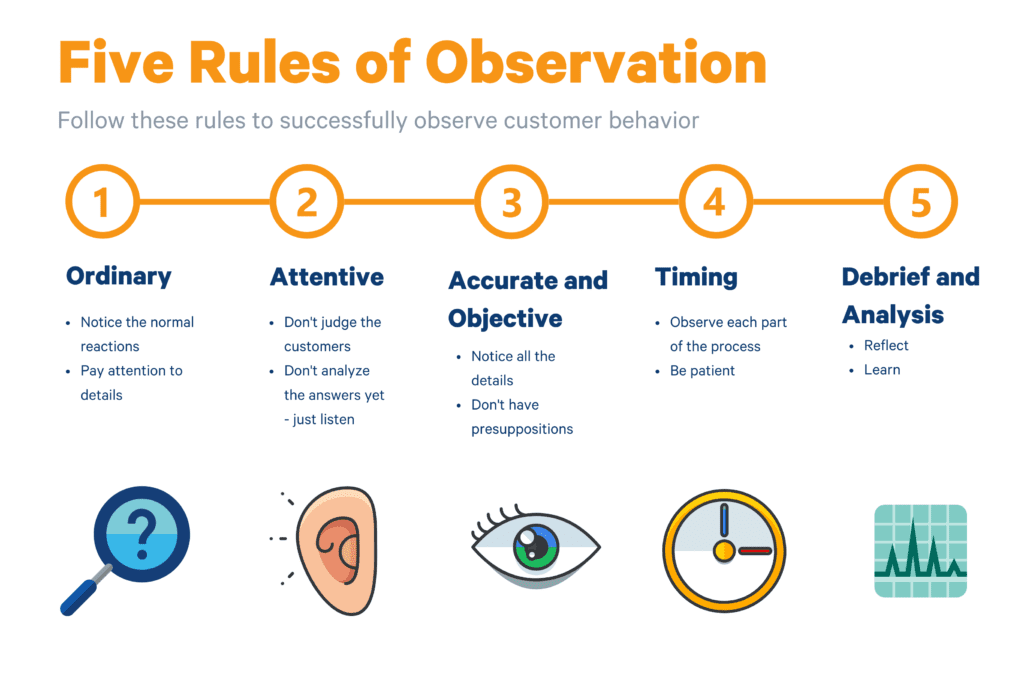
2. Interviews
One-on-one interviews can give the customers a feeling of individual attention. When interviewing a customer, it is important to focus on the right questions.
There are many types of questions you can ask. However, the right questions will circle five main areas. These include:
- Expectation Fulfillment
- Feelings And Emotions Experienced
- Ease Of Doing Business
- Creation Of Strong Memories/Stories
- Future Loyalty
- Expectation Fulfillment
Fulfillment of expectations can lead to customers being truly pleased with the brand. Hence, it can be vital to know about these expectations beforehand. Some questions you can ask in interviews can be:
- How did your experience and expectations differ?
- Were all your expectations met?
- Were any expectations exceeded/not met?
- Feeling And Emotions Experienced
Asking your customers questions about feelings and emotions can help them explain their experience.
These questions can be formed as:
- What did you feel when…?
- Did you feel valued as a customer?
- How would you describe your emotions while interacting with our team?
Pro Tip: You can use the feelings circle to help customers pinpoint their exact feelings and emotions.
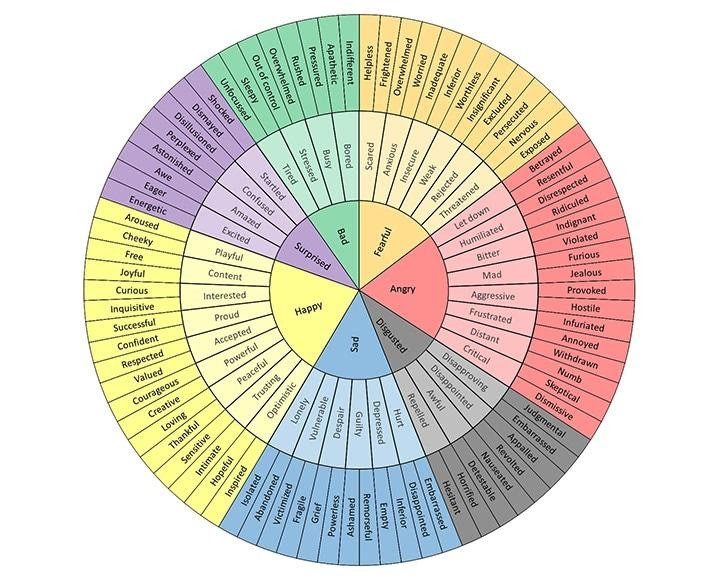
Ease Of Doing Business
This parameter links to CES. While discussing the ease of doing business, you can invite the customers to make suggestions.
Below are some examples of how you can do so:
- Do you feel our website is easy to navigate?
- How easy/hard was the process of ordering the product/service?
- How can we improve the process to make it easier for you?
- Creation Of Strong Memories/Stories
Creating strong memories allows the customers to form a deep connection with the brand.
Asking questions about stories can help fortify them in the customers' minds.
Some questions that can help you do that are:
- What are some highlights of your experience?
- Did you share the experience with your friends/family/colleagues?
- How would you describe this experience to your friends and family?
- Future Loyalty
The question regarding future loyalty is linked to NPS. Some brands have modified the NPS question so that it reflects actual past recommendations.
Thus, the question becomes:
"Have you recommended us to family/friends/colleagues?"
Furthermore, you want to ask questions that allow customers to explain their experiences. 'Open-ended questions,' more on that later, can be a potent tool in an interview.
3. Open-Ended Questions
Open-ended questions allow customers to talk and explain their thoughts, emotions, and experience.
Furthermore, they can even make suggestions that can help you improve your current strategy.
Open-ended questions begin with the following words: why, how, what, describe, tell me about..., or what do you think about...
The following are some examples of open-ended questions.
- Why are you likely to recommend this product to your friends/ colleagues?
- How can we improve your satisfaction with our company?
- What do you think about this product?
- Tell me about the experience you had when dealing with company X
- What do you think about the new marketing strategy of company Y?
The answer to these questions can be long and carry much detail. Thus, it is vital to analyze these answers and look for trends, common points, recurring positive/negative themes.
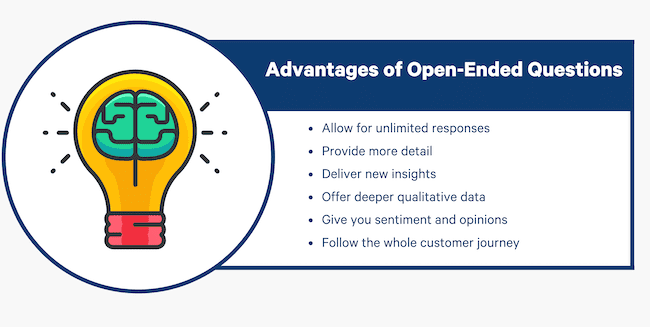
Pro tip: you can collect feedback from customers with the help of chatbots!
4. Surveys & Questionnaires
One-on-one interviews can lead to customers spending the entire interview focusing on one question. Furthermore, they are limited in scale.
There are times when you want the customers to answer multiple questions. That is where surveys and questionnaires can help you out.
Surveys help ask a series of questions quickly. You can think of questionnaires and surveys as conducting interviews on a larger scale. Thus, it can be an effective tool for gathering huge amounts of customer feedback.
The following list shows the many types of questions you can use in your surveys and questionnaires:
- Multiple Choice Questions
- Likert Scale Questions
- Matrix Questions
- Dropdown Questions
- Demographic Questions
- Ranking Questions
- Image Choice Questions
- Click Map Questions
Multiple Choice Questions
These questions offer many choices of answers. They are simple and easy to use for customers as they only need to pick the most suitable option rather than think of an answer.

Likert Scale Questions
Likert scale questions are used to judge the customers' opinions and feelings. These questions give the respondents a range of answers, for example, "not at all likely" to "highly likely."

Matrix Questions
Matrix questions allow you to ask a host of different questions that have the same response options. A series of Likert scale questions can combine to form matrix questions.
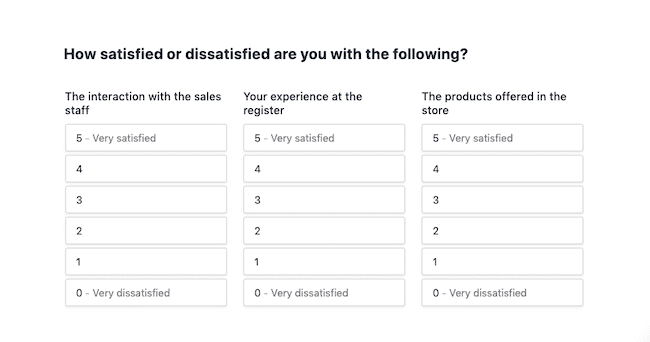
Dropdown Questions
Dropdown questions are basically multiple-choice questions that don't overwhelm the customers.

Demographic Questions
Demographic questions help create customer profiles. These questions can be powerful tools to segment your customers w.r.t. their age, gender, occupation, relationship status, etc.

Ranking Questions
Ranking questions can be ideal to understand customer preferences. However, they do require that customers are aware of all the choices offered. Furthermore, they can be a bit time-consuming.
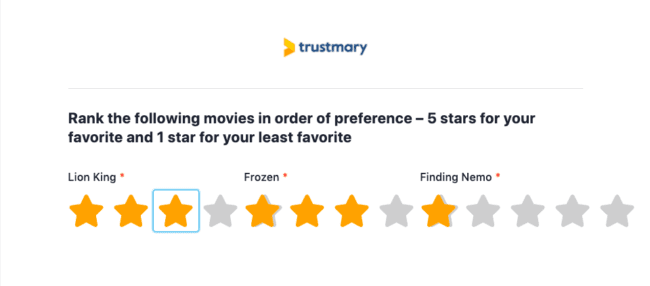
Image Choice Questions
Customers answer these questions by selecting an image. Suppose you want customers to vote on various potential logos for a new product. In that case, an image choice question will be perfect as the customers can view and choose the image that appeals to them.
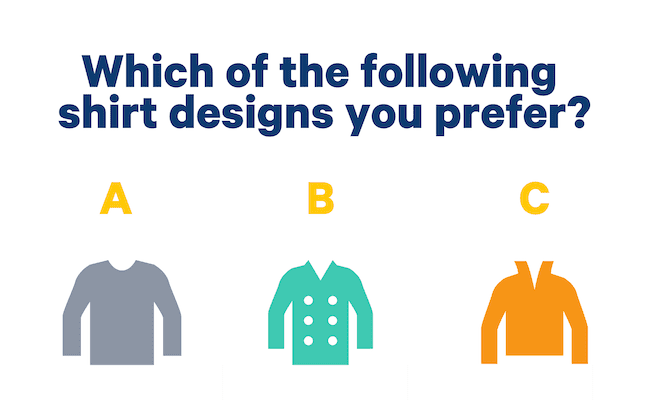
Click Map Questions
A click map question asks customers to click on a specific part of the image. For example, showing the product packaging image and asking customers to click on the part intrigues them.
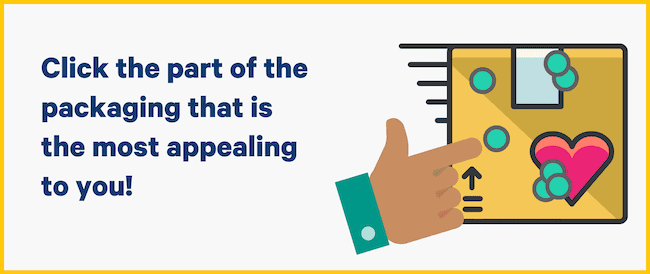
SuperValu is a good example of a brand using questionnaires and surveys to collect feedback. They conducted discussions with 12 customers twice a month to reflect on the price, quality, service, and ad promotions.
The feedback was used to enhance the planning procedure of store managers.
5. Focus Groups And Customer Insights
Lastly, let's talk about focus groups.
Focus groups are composed of individuals chosen based on demographic analysis. They have a common trait that allows them to come together and discuss the brand/product/service.
A moderator helps keep the discussion on track while generating as much information about the specific topic. It will be helpful to note that the moderator should not introduce personal bias.
After the focus group has concluded, the collected information is analyzed. The analysis can help recognize spaces for new products or services.
You can compile the data from the group process in a day. Whereas compiling data from surveys and questionnaires might take weeks.
Focus groups allow companies to study a limited sample size of potential customers. It allows them to observe patterns and behaviors that can represent the masses in general.
Furthermore, it allows brands to predict customer reactions before launching their products/services. Thus, it can help save millions of dollars.
The fluidity of focus groups allows you to gather data about specific topics or the overall customer experience.
Thus, you can design groups that offer insight into customer service representatives' performance.
Moreover, healthy interactions within the group can lead to recommendations and suggestions. These suggestions can help the company deliver an enhanced customer experience.
Why Is NPS The Best Metric For Measuring Customer Experience (7 Reasons)
In the previous section, I have shown you many metrics to measure customer experience. Some of them help measure minute changes, while others help you dive deep into customers' feedback.
Yet, which one of them stands out to be the best metric for measuring customer experience?
The best metric for measuring customer experience is the Net Promoter Score (NPS). It is the most popular metric; used by two-thirds of Fortune 1000 companies.
"If you do build a great customer experience, customers tell each other about that. Word of mouth is very powerful" – Jeff Bezos
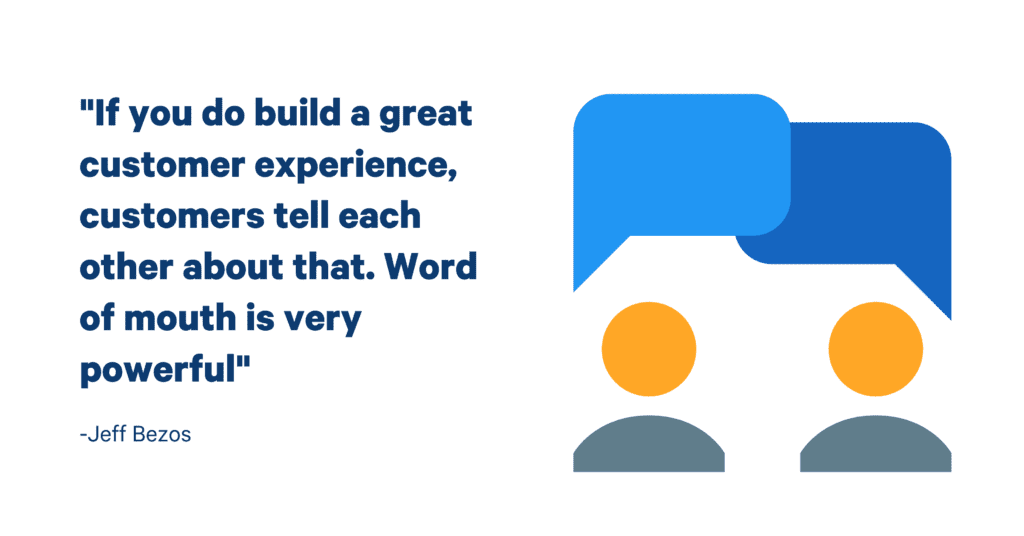
The above quote highlights customers acting as marketers for the products/services/business. NPS is the measure of customers who act as marketers on the company's behalf.
The following are seven reasons why NPS is the best metric for measuring customer experience.
1. It measures the likelihood of repeat business
NPS separates the customers into three categories (Promoters, Passives and Detractors). These categories help forecast business growth, cash flow, and gauge customer satisfaction.
2. It provides the big picture
NPS focuses on the entire customer journey and provides a complete look at the experience. In contrast, CSAT and CES surveys are based on the customers' last interaction with the business. Hence, they only capture a part of the customer experience.
For example, an unhelpful service call may skew the CSAT or CES scores negatively. Yet, the customer might still enjoy the product, company, social presence, etc.
Make sure you have a strategy in place on how to handle difficult situations with customers, so they don't turn into difficult customers.
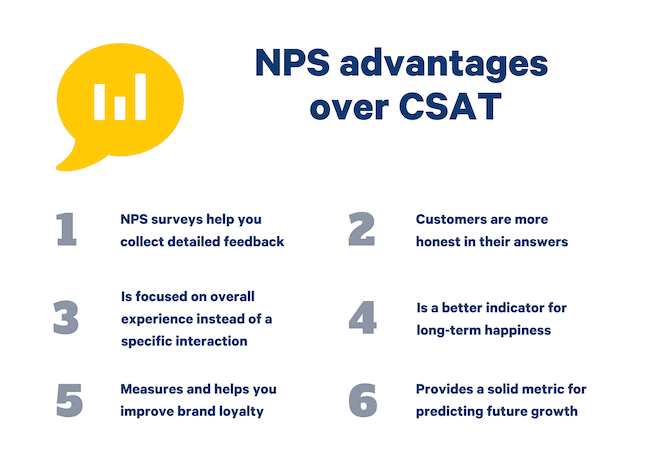
3. It's relevant to everyone
Since NPS is a measure of the entire business, it's relevant to every individual in the company. Hence, a strong NPS reflects that all the components of the business are doing a good job.
Likewise, a weak NPS can state that one or more links in the chain need to be sorted. Hence, it can become the basis for further positive change.
4. It gives direction for change and improvement
Building on the previous point, NPS offers you a clear number of people who wouldn't recommend your business. Thus, you can use it to probe deeper into their problems.
Coupling NPS with follow-up questions and surveys allows you to use its full potential. You can target the detractors and get their feedback to introduce meaningful change that can lift your company.
5. It's simple, user-friendly, and inexpensive to put in place
Measuring NPS is as easy as asking a single question. It takes less than five minutes to complete. Furthermore, you can distribute the survey over various channels (phone, email, SMS).
6. It helps track change over time
NPS shines when it is used to measure changes over time. Tracking NPS over time allows you to notice trends and track business performance while trying new strategies.
Furthermore, you don't have to limit it to the entire company. You can use NPS to track the progress of specific teams and departments in the company and compare them.
7. It is easier to benchmark against competitors
NPS is globally recognized and used by leading brands. Thus, you can find benchmarks of your specific industry and compare your business to market leaders. Furthermore, you can even investigate local benchmarks.
In contrast, metrics like CES and CSAT have a lot of variables that determine their final score. Thus, it can be difficult to find accurate industry-specific benchmarks.
The NPS turnaround by British Gas is a shining example of the usefulness of this metric. British Gas was losing money on its home heating installation business.
They trained their employees in the NPS framework. They developed a daily NPS reporting process for employees in all their districts.
This framework, coupled with engineers calling the customers and asking for feedback, increased NPS from 45 to 75 percent.
The decrease in customer complaints decreased led to fewer employees for complaint resolution. Furthermore, customers started to pay their bills on time, which led to positive cash flow.
The following articles can further enhance your understanding of NPS and why it is the best metric for measuring customer experience:
Different Channels to Measure Customer Experience
You have learned how to measure customer experience. Now we will look at the different ways you can connect with customers and send out your surveys.
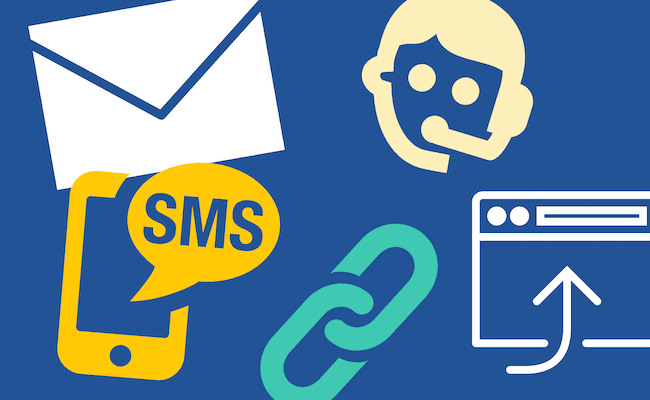
The following are some of how you can reach customers and ask them about their experience.
Phone
The telephone allows people to talk over large distances. It is now seen as a traditional tool for connecting with customers. Telephonic conversations offer the most 'human' experience. Customers can have a flowing conversation with the representatives.
It can also be ideal for less tech-savvy individuals who would prefer to call the company.
You don't need expensive software to have excellent phone support, most small business phone services will cover all of your needs affordably.
Emails can be tailored according to the needs of the brand. Furthermore, they can be sent out to many consumers at the same time. You can even ask for customer feedback on an upcoming product and understand customers' needs with a well-crafted email.
However, email is a more delayed mode of communication. Yet, it offers unparalleled global out-reach. Busy consumers who do not want to engage in a long discussion prefer communicating via email.
This article offers some tips on sending NPS email surveys for maximum results.
SMS
SMS, or short message service, is a combination of email and phone. SMS is used for quick responses.
It is a personalized message that can be vital to gathering feedback. SMS allows you to send the same message to multiple consumers at the same time. Thus, combining this channel with quantitative metrics is a winning combination.
Furthermore, you can customize messages to offer automated responses that feel humanistic. The connection made through SMS is more personal.
Website
Your website can be a source of knowledge to the customers. However, it can also help you gather feedback.
Attractive-looking websites make the process straightforward and help guide customers through various sections.
The enormous space of the website allows you to incorporate full-fledged surveys. Thus, consumers can detail everything about their experience.
Moreover, you can allow customers to converse with customer care representatives. You can do this by incorporating a live chat feature. Thus, you can engage with a large share of customers on your website.
The best thing about a website is transitioning from purchasing a product or service to giving continuous feedback. Thus, preserving the raw emotions, feelings, and thoughts of the customers.
Learn how to gather website NPS by reading this short guide.
In-App
In-app customer feedback has become very popular in recent years. Companies usually gather quantitative feedback.
The convenience of registering the feedback using a single tap is something that the customers appreciate very much. Successful apps collect customer feedback and measure user experience. Then they ask customers to write a review without hassle.
Many companies feature multiple channels that allow them to cover a wider customer base.
Allowing more customers to register their feedback increases the growth potential. Furthermore, it helps form a lasting relationship with them.
Casper, the mattress company, used channels to connect with customers.
They created a chatbot named 'Insomnobot3000'. This chatbot would allow customers to have real conversations through their mobile. However, that was not all.
Through the chatbot, Casper collected mobile numbers and offered discounts and promotional offers. It is estimated that within the first year of launching 'Insomnobot3000', Casper generated over $100 million in sales.
When And How Should You Measure Customer Experience?
Let's apply metrics and channels we have gone through to a customer journey.
A Framework Of The Customer Journey

Let's start by overviewing the customer journey.
Customer journey maps help visualize the customers' interactions. Companies gain insight into their clientele. Furthermore, they help inform about the customers' experiences through all the different touchpoints that the customers.
At What Points Should You Use What Metrics For Measuring Customer Experience?
"Successful CX programs require aligning everyone in your organization with your customers' goals. Ultimately, delivering the experiences your customers demand comes down to monitoring and measuring your customer's journeys, so you can identify the best opportunities for improvement. " - Jeannie Walters, CCXP.
Follow the link to have a better understanding of the customer experience at the beginning of the journey.
Many designers quickly get overwhelmed when matching custom journey maps and metrics.
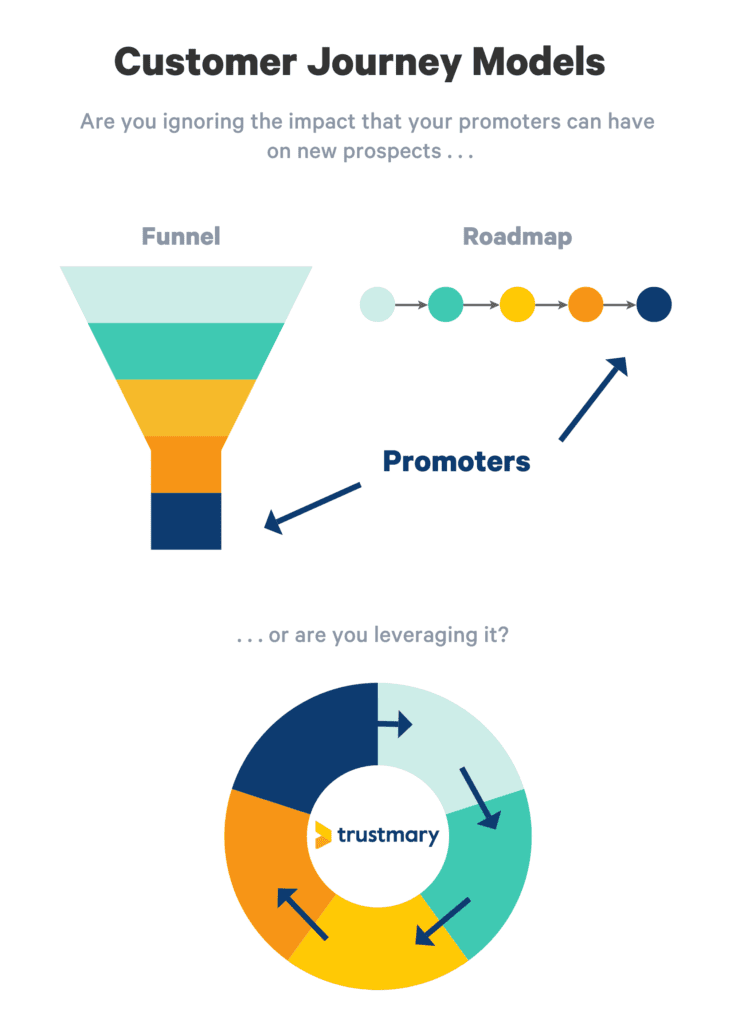
The following are some questions that you should consider when matching metrics with a customer journey.
- Should I measure the entire journey or specific touchpoints?
- Which metrics should I use?
- What metrics match with a specific point in the customer journey?
The best solution lies somewhere in between the extremities of those questions.
The following is a step-by-step guide that will give you a solid base for matching your metrics with the specific journey of your customers.
1. Measure The Entire Customer Journey
This first step looks at the customer journey as a whole. We need to find a metric that helps represent the entire journey simplistically.
The guiding question in this step is, "As a whole, how efficient is our customers' journey?"
Many metrics can help you at this stage. We prefer using quantitative methods as they offer a single representable number for the entire experience.
Metrics like the NPS, CSAT, or CES score cover a broad base to capture the entire journey.
Some studies show that CES is better suited for predicting repeat customers and increased spending.

Yet, the consulting firm McKinsey says that maximizing the satisfaction of a customer journey can help increase happiness and revenue up to 15 percent.
It will be beneficial to use many metrics to get a complete picture of the customers' experience.
2. Align Metrics To Purchase Journey
The purchase journey differs from business to business. It usually contains about four to five steps, and each step will have a different metric.
A general framework for the purchase journey is shown below.

Awareness
The essential question at this stage is that "are customers aware of your brand, products, services?"
Some metrics that can help you tackle this question can be the share of voice (SOV) and the number of visits your site receives.
Consideration
The main question you should ask is, "When the customers want to buy the type of products we sell, are we considered as an option?"
You can use metrics like keyword traffic, website traffic, and retail store visits to measure this.
Purchase
Imagine that the customers have begun their purchasing process. Are they finishing their purchase? By answering this question, you can look deep into the habits of your customers.
Some metrics that can help you do this are cart to completion rates, abandoned cart rates, and footfall in stores compared to purchases.
Retention
Customer retention plays an important part in keeping the business running. Questions like, "are the customers returning for more purchases?" can help your business turn a profit.
Customer Lifetime Value (CLV), return visitors, customer service ticket volume, session length, frequency of session are metrics that can help you measure the retention rate.
Advocacy
Advocacy is the customers' will to recommend your brand. Customers who advocate your brand become brand ambassadors who can convert potential customers.
NPS is specifically designed to ask this question. Checking sentiments, reviews on social media, and referral codes at specific points can help you out.
3. Define Metrics For Specific Touchpoints
Touchpoints can either make or break your customers' experience. The essential question you should ask is, "Do our touchpoints enhance the customer experience?"
Let's look at some examples of physical and digital touchpoints metrics to have a better understanding.
Physical Touchpoints
- Retail Stores
- People visiting vs. number of purchases
- Basket size
- Overall sales in retail
- Number of queries to staff
- Retail Point Of Purchase Communications
- Sales increase of featured product
- Visual prominence
- Overall sales uplift
- Halo effect on sales in similar categories
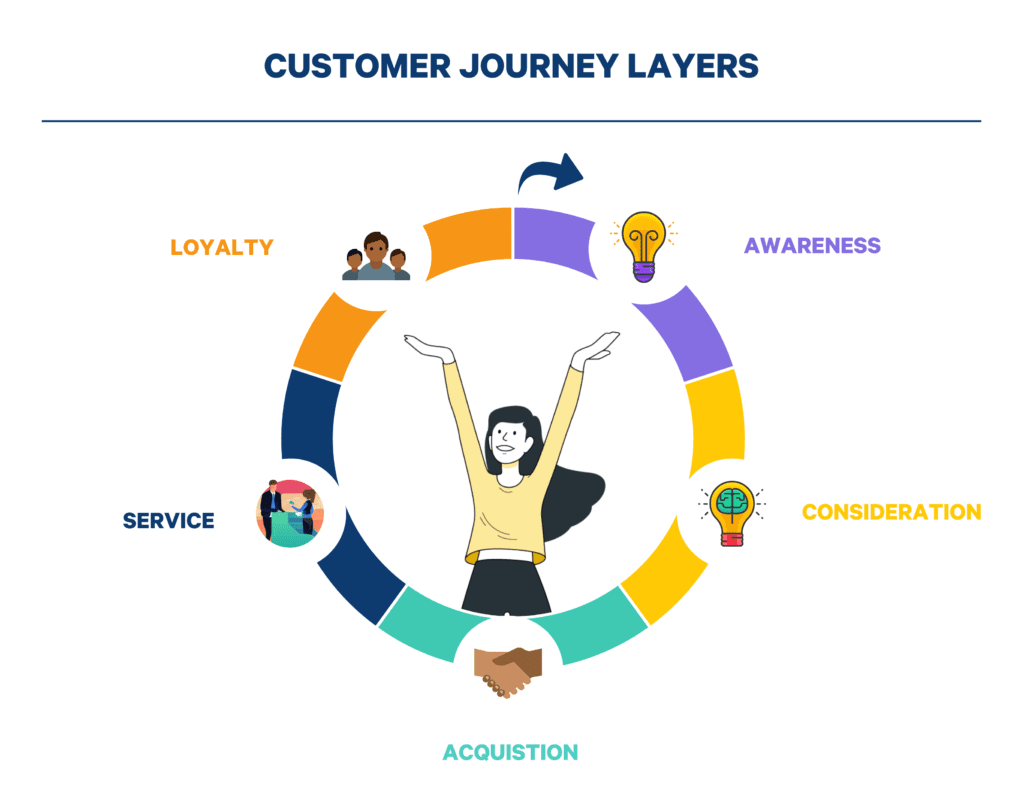
Digital Touchpoints
- eCommerce Website
- Uptime, drop-off points,
- Bounce rate,
- Loading speed,
- Mobile page performance,
- Dwell time
- Online Chat Support
- Length of support interactions,
- Customer satisfaction surveys post-chat,
- Repeat purchase from customer,
- Wait-time,
- Customer sentiment in chat
Specific touching metrics carry significant importance. You need to know the exact point at which your customers feel not looked after.
Adidas provides a brilliant example of digital customer experience done right. They noticed that customers are attracted to online shopping. Hence, they created a personalized customer experience using data insights.
By investing in customer experience in the digital space and listening to customer feedback, they sold over 1 million pairs of shoes in a year.
The above method and example have given you some ideas to make a unique customer experience measuring strategy.
How To Analyze Customer Experience
So you've sent out the survey and got results. Now it's time to analyze your findings.
Analyzing the customer experience gives you an insight into the customers' minds. Furthermore, you get to see repeating trends and study the cases of outliers.
Analyzing the customer experience is the first step to addressing various issues and concerns faced by the customers.
After gathering all the data points, it can be helpful to address the individual complaints. Furthermore, you can also view the cultural mindset surrounding the issue or problem.
Let's look at these concepts separately.
Micro-Level Issues (Individual Complaints)
To analyze micro-level issues, managers or supervisors can reach out to customers who made the complaint. This process requires interpersonal skills to listen to their story.
- If the issue comes from the failure of an employee, the manager can commit to educating them.
- Suppose the reason behind the complaint relates to a company policy. In that case, the manager can explain the reasoning behind the policy or discuss it with the policymakers.
Macro-Level Issues (Cultural Mindset)
To analyze macro-level issues, you need to take a step back and look at the big picture. This process does not include every customer. Thus, it can be ideal for focusing on your most valued and perfect customers.
To get the highest impact, make sure you focus on the following factors:
- How common is the experience? Does it affect 4% or of your users? Or 40%?
- How serious is the issue? Does it keep people from converting? Or is it a minor annoyance?
In the early 2000s, Microsoft was not showing significant growth. The new CEO focused on creating a strong presence on various social media platforms. This presence helped them highlight micro and macro-level issues.
By listening to customer feedback, they created new products that helped their customers. Which, in turn, helped their business grow.
In the following section, I will show you some ways to improve your customer experience.
How To Improve Customer Experience?
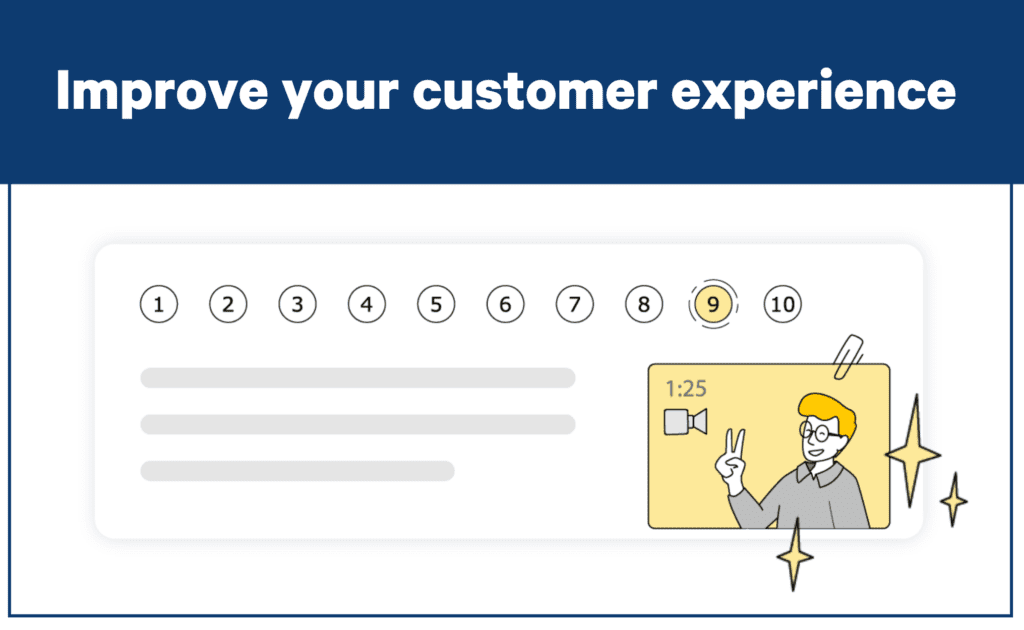
There are many ways to improve customer experience. Once you master improving your CX, you're one step closer to that unicorn-like growth!
We have listed down the seven most important steps to do so.
- Create A Well-Defined Customer Experience Vision
- Understand Your Customers
- Create An Emotional Connection
- Capture Real-Time Customer Feedback
- Use A Framework For Team Development
- Listen To And Act Upon Regular Employee Feedback
- Measure The ROI
1. Create a Well-Defined Customer Experience Vision
The first step is to create a set of statements that act as a guiding principle for the organization. Embed these principles into the training, development, and behaviors of the individuals.
2. Understand Your Customers
One way to understand the customers is to create general customer profiles. These personas will help your team understand customers' problems.
3. Create An Emotional Connection
Customer loyalty is not dependent on the number of various products or services you offer. It is dependent on the emotional connection that you make with your customers. Your products and services must aim to fulfill the customers' needs rather than showcase your technical know-how.
4. Capture Real-Time Customer Feedback
By having real-time data, you can analyze whether your customers are pleased or not. You can use various channels and deploy a combination of metrics. Thus, you can figure out where customers are feeling delighted and what points are problematic.
5. Use A Framework For Team Development
A quality framework will help you cater to the individual training of all your team members. By using a set framework, you can identify the needs of every member and follow their progress.
6. Listen And Act Upon Regular Employee Feedback
Regular employee feedback can help you assess the situation in the team. The staff can share ideas on how to increase the customer experience. Furthermore, they can voice their concerns about a particular direction that the company is taking.
7. Measure The Roi
You can use any one of the many quantitative or qualitative metrics to know if the strategy is working or not. Customer experience relates to the success of a business.
The Peak End Rule
The Peak-end Rule states that people's judgment of an experience depends on how they felt its peak and its end. That means that their customers will remember the best/worst part of the experience and its end for companies.
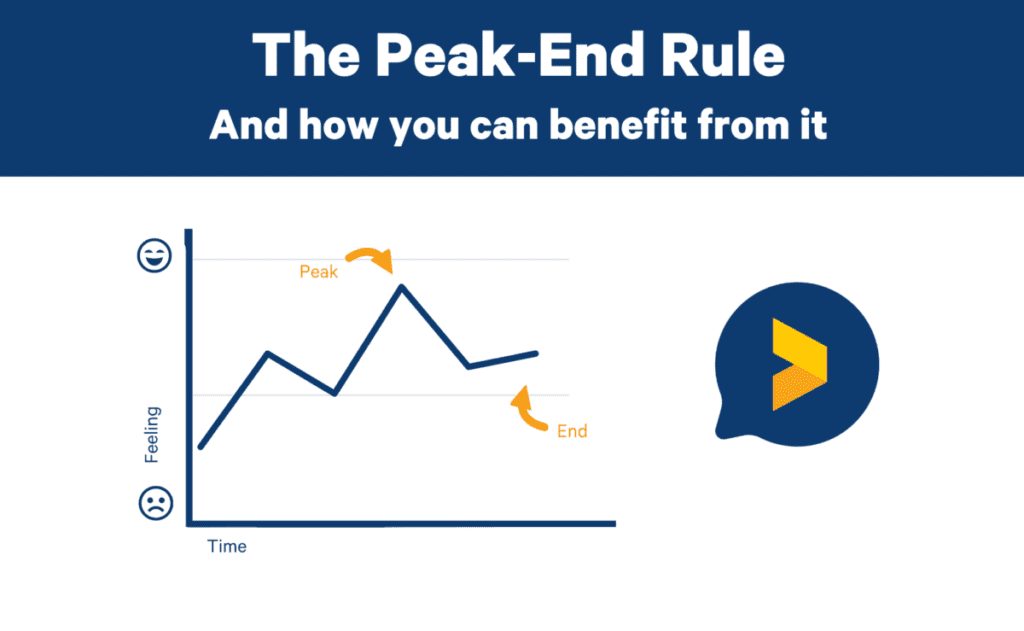
Hence, your company does not have to tweak every single touchpoint until it's perfect. By making efficient changes at the peak and end, you can create a massive shift in customer experience.
The following are three tips you can use to enhance the customer experience and make it memorable.
1. Speak In Your Customers' Language
Go through the feedback data and pick out common pain points. It will help if you can explain how you plan on dealing with those occurrences.
By highlighting testimonials, you can show that you have done it before. You can also include FAQs that offer value to potential customers. Using the customers' own words can be very impactful in these situations.
2. Train Your Team To Listen
Some customers appreciate speaking to humans. Thus, you have to train your sales team to listen first and listen empathically. It will allow them to better connect with the customers' problems and offer solutions that benefit both parties.
3. Don't Make People Wait:
Customers don't like waiting. Connect with customers and let them know about the sale or the shipping information as soon as possible.
Furthermore, if there are any changes to the schedule, let them know.
After catering to the peak-end rule, you can move towards tweaking other touchpoints. Hence, you can enhance the customer experience further.
You can do this by:
- Offering a frictionless and human experience
- Creating an everlasting impact
- Facilitating the customer in every step of their journey
Improving the customer experience is about realizing where customers encounter turbulence. You can create an environment where the customers feel secure and valued to speak their honest minds.
Customer Experience Softwares
This section will cover various customer experience management softwares that are used to measure customer experience.
Trustmary
Trustmary offers a unique method for measuring customer satisfaction, collecting customer feedback, and getting reviews and testimonials all in one survey.
Businesses using Trustmary can stay on the pulse of their customers, react to changing customer satisfaction trends, make data-driven decisions, and enrich customer information with satisfaction data.
Moreover, Trustmary enables businesses to use their loyal customers as an effective marketing strategy. By showcasing happy customers' testimonials and reviews on the website, businesses can increase conversions on average by 20%.
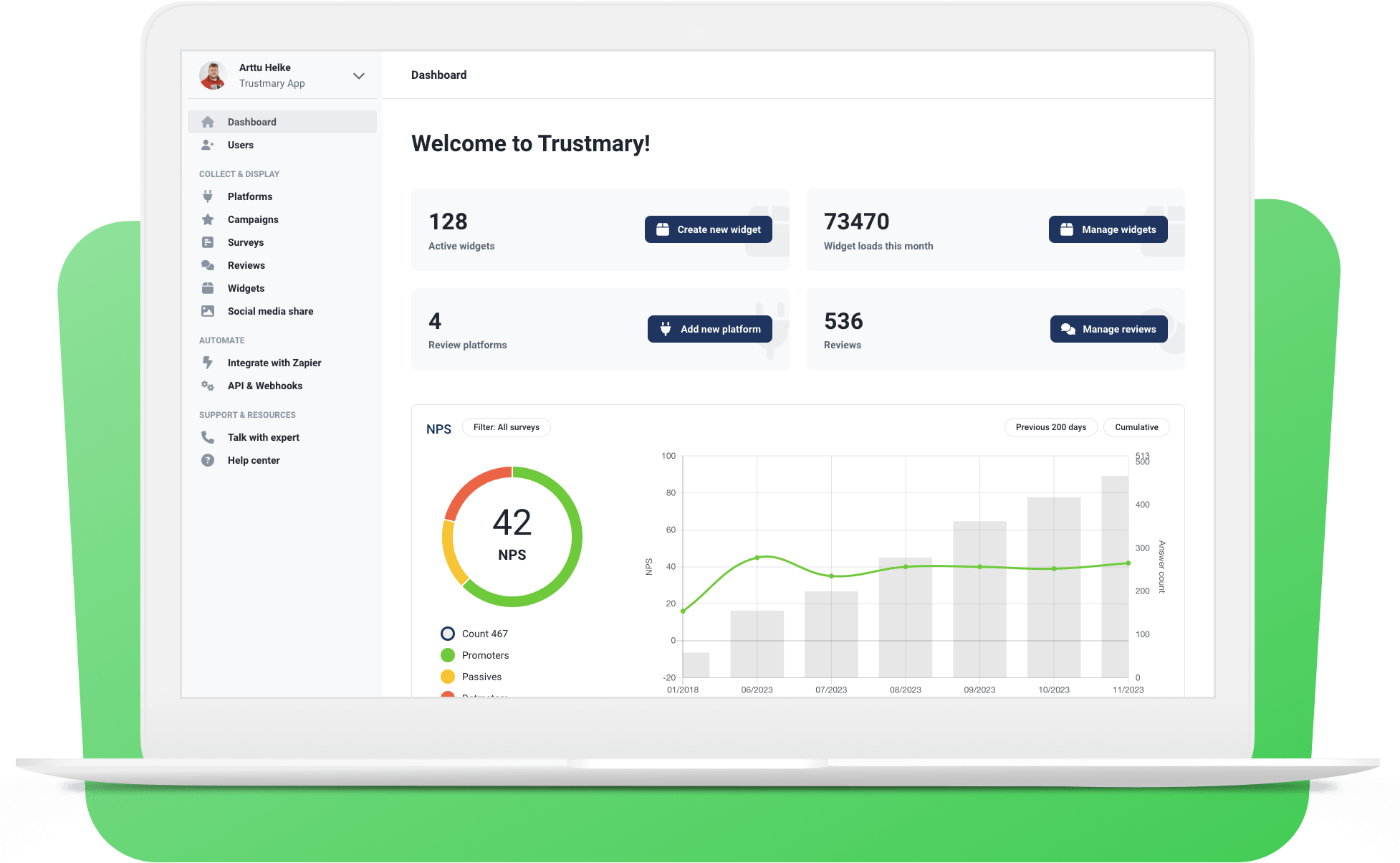
Lumoa
Lumoa uses artificial intelligence to collect insight from customer feedback automatically. This cloud-based software allows for multi-channel data collection and features a comprehensive dashboard. Lumoa makes it very easy to assess the impact of customer-orientated activities on clients. Furthermore, users can easily see the trends behind various metrics.

Listen360
Listen360 is an NPS-based customer feedback system. It makes it easy for customers to answer the question. It also analyzes the answers for greater insight. Furthermore, the feedback can be tracked in real-time. It goes through 'Voice of Customer' to gather specific words and phrases that help users see key pain points.
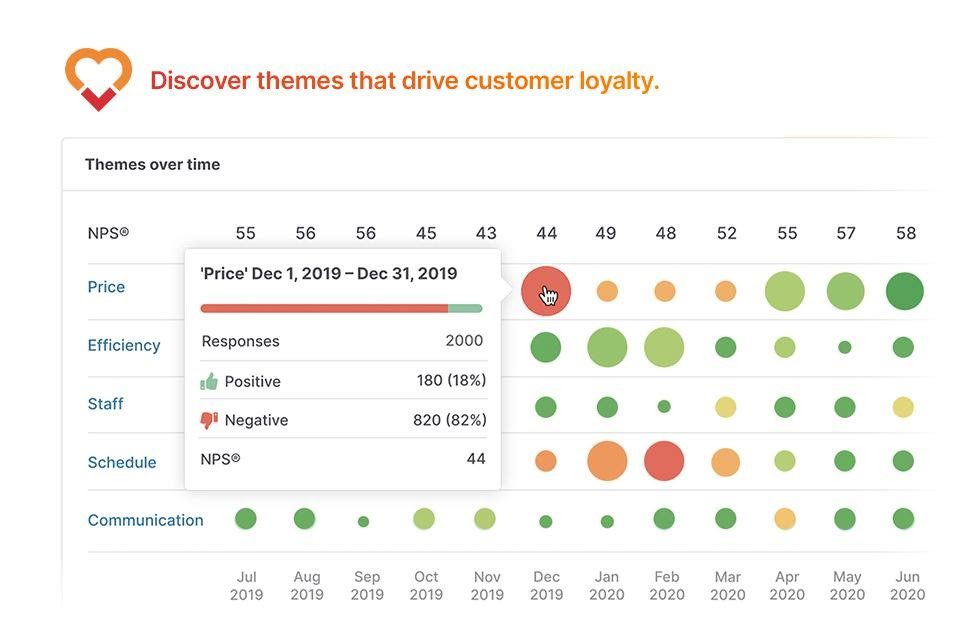
Zonka Feedback
Zonka Feedback allows users to create customizable surveys. You can distribute them over various channels. Furthermore, it organizes the incoming data and provides insights. Thus, users can engage in result-orientated action that helps close the feedback loop. It offers multi-lingual surveys, which are useful for international businesses.

Startquestion
Startquestion is based on calculating NPS. It offers ready-made surveys which can be tailored to your specific needs. You can select the gradual distribution option. Thus, you can observe dynamic changes and ensure continuity of measuring customer experience. It offers notifications and weekly reports too.

We have dedicated a whole article for NPS measuring software specifically, if you want to explore more options.
Survey Templates From Top Brands
This section shows surveys of three of the most popular companies in the world. We will see various examples of quantitative and qualitative metrics being put to use.
McDonald's
McDonald's runs an online portal called McDVoice. It showcases a beautiful example of customer-centricity (customers' feedback matters).

Nike
In this example, we look at Nike. They ask specific questions relating to the greeting of customers in their retail stores. Their customers can pick a number and leave textual responses. This model uses a combination of quantitative and qualitative metrics.

Starbucks
Starbucks gets their customer appreciation due to their crisp questioning. This line of questioning helps them gain relevant insight into the customers' needs and tailor their services accordingly.

Note that these companies use a customized look and feel to match their branding style.
How Does Employee Experience Affect Customer Experience?
What Is Employee Experience?
Employee experience defines how companies develop, nurture, and grow an employee-centric culture. Some questions that come up when making an employee-centric culture are:
- How can we set our employees to be most successful?
- How should we give them control of their careers?
- How do we help them set and achieve their goals?
- How do we help them grow and succeed in the workplace?
Happy and satisfied employees help create happy and satisfied customers.
Imagine being a customer and walking in to see disgruntled and displeased-looking employees. Immediately, you would start forming a judgment related to the brand itself. And not a good one at that.
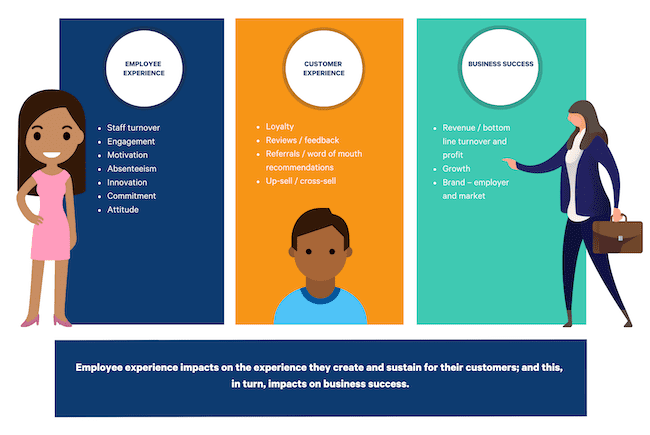
How Are Employee And Customer Experience Linked?
Research shows that engaged employees can lead to a better customer experience. This effect is clear when you look at the numbers. Companies with a high customer experience have almost two times more satisfied employees.
Simply put, satisfied employees will not look at customers as another hurdle. The customers would represent an opportunity for the employees to grow in their field.
Southwest Airlines has been ranked as one of the best places to work due to its 'employee-first culture. The company reminds its employees to enjoy and take pride in their work.
The result is a long-lasting positive customer service experience. Southwest Airlines' employees go above and beyond for their customers. One such incident occurred in 2011 when the pilot waited for a man who booked a last-minute flight and got stuck in traffic.
This case study can help you have a better understanding of customer and employee experience.
What Is Customer-Centricity?
Customer centricity is a strategy that puts the needs of the customers at the core of the business. It offers a positive experience to the customers that can help build a lasting relationship with the company.
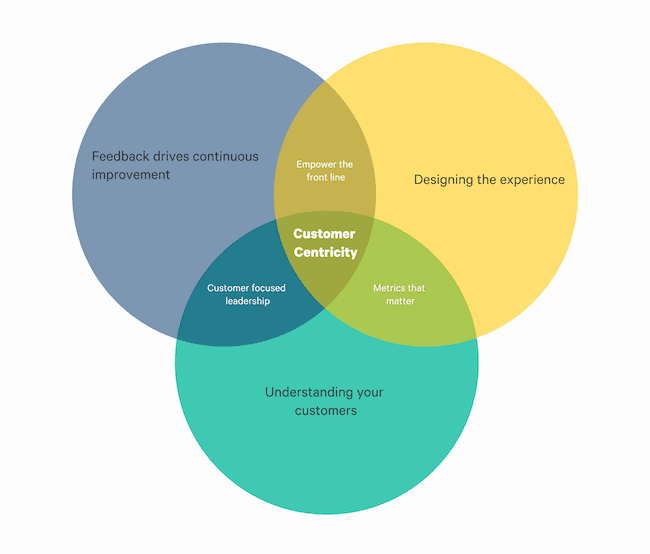
You get a wealth of data by making the customers the center of attention. This data can help give you a complete picture of the customer experience.
Applications will allow you to understand the buying behavior, interest, and engagement of the customers. Furthermore, you can also look at gaps to introduce new products, services, and promotions for your ideal customers.
Deloitte and Touche show customer-centric companies generated 60% more revenue than their counterparts.
To become custom-centric, companies have to go through a major shift in structure and ideology. However, the reward is worth the effort. There are only a few things better than offering your customers an experience they won't ever forget.
Conclusion and Next Steps
In summary, this guide was created to cover different topics related to customer experience.
This guide has shown the following:
- The explanation and importance of customer experience
- How to measure customer experience quantitively and qualitatively
- The best metric for measuring customer experience
- Different channels you can use to connect with your customers
- How to measure customer experience through the customers' journey
- How to analyze and improve customer experience with a focus on the peak-end rule
- Leading software to help measure customer experience
- The relation between employee experience and customer experience
If you want to start measuring and improving customer experience fast, we can help you.
Trustmary offers you a unique method of measuring customer satisfaction, collecting customer feedback, and getting customer reviews and testimonials with one survey.
Additionally, Trustmary can help you make use of the feedback and reviews in new customer acquisition.
Start collecting feedback yourself with a free trial, or let us show you how to build an efficient feedback process for your company's unique needs.
Book a meeting with us or start using Trustmary from the link below:
FAQs About Customer Experience
Should I thrive to improve customer experience?
Yes, a fulfilling customer experience can help sustain the growth of your business. It also helps promote brand loyalty, customer retention, and brand advocacy.
What is the ROI of improving customer experience?
Customer-centric companies are 60% more profitable compared to companies that don't focus on customers. Brands with superior customer experience bring in 5.7 times more revenue than competitors. 84% of companies that work to improve their customer experience report an increase in their revenue.
What is an example of a good customer experience?
Imagine a retail store. A good customer experience will include the staff remembering and appreciating repeat customers. Furthermore, they will strive to form a connection with the shoppers. Moreover, the store will put the product knowledge to good use to offer value to the customers.
What is an example of a bad customer experience?
Imagine a company that isn't available to cater to customers' queries and requests. Furthermore, they have poor automated phone prompts, long wait times, and multiple line transfers. Moreover, the representatives will offer cookie-cutter solutions to complex problems.
How is customer experience measured?
Customer experience is measured quantitatively and qualitatively. Some quantitative metrics include NPS, CSAT, and CES. While qualitative data can be collected using surveys, focus groups, and open-ended questions.
How often should I measure customer experience?
During a customer journey, you should measure customer experience after every stage and at the end as a whole.
For the long run, you should measure custom experience at least two times a year. Measuring customer experience repeatedly will help you catch on to any trends.
What questions should I ask to measure customer experience?
The following are a few questions that can help you calculate customer experience:
- How likely are you to recommend this business to a friend or colleague?
- How easy was it to solve your problem today?
- How satisfied were you with [company]?
- How can my company serve your needs better?
